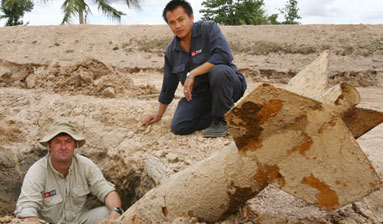|
Bomb HarvestDirected by Jim Mordaunt, 2007 Review by Rada Djurica The Sixth annual Zagreb Film Festival this year offered a very good documentary program. There was one documentary that especially attracted attention. It is Bomb Harvest, produced by Lemur Films Australia, established by director/screenwriter Kim Mordaunt and producer Sylvia Wilczyinski, a couple who have made award-winning dramas and documentaries for ABC TV, SBS TV and Discovery. Their documentary Bomb Harvest has won prestigious awards, and was received very well by audiences in Hollywood. The subject of the film is the Vietnam War. During that war, the United States government bombed Laos without any public knowledge or approval from the relevant authorities. Today, Laos is very poor country, coping with the leftover bombs from this secret air war of the late '60s and '70s. The U.S. government dropped two million tons of bombs over nine years, in order to stop the flow of troops and munitions from North to South Vietnam via the Ho Chi Minh Trail. This makes Laos the most bombed country on earth. The problem is that up to a third of the bombs, didn't go off and are still buried there. According to Landmine Monitor, the research of the International Campaign to Ban Landmines, the U.S. gave about $3.2 million in 2005, but each year of the Laos bombing cost the US more than $1 billion. This documentary chronicles the Big Bomb Training Project, funded by the U.S. State Department but managed by the Swiss Federation for Mine Action and the British-based Mine Advisory Group. The film follows everything from children in the classroom to jungle bomb cleanups. There are still 500-pound bombs sticking out of idyllic green fields and water ponds today. Those children learn the most dangerous trade in Laos: how to disable bombs. Their teacher is Australian Laith Stevens, who has learned the bomb-clearing trade in the Australian Army. Mordaunt and his wife, producer Sylvia Wilczynski, followed him and his team to the southern provinces, to the remote villages where those bombs are close to the surface. Their camera followed the dealers come from Vietnam to buy whatever the villagers bring in from the forest as metal scraps. A big bomb can be worth up to $20, which is a small fortune for starving village children. And a completely intact bomb case, they're told, might feed one family for two or three months. Despite the grisly and potentially depressing subject of the film,
Bomb Harvest is an entertaining documentary. As it follows the
work of expatriate Australian bomb disposal expert Leith Stephens, the
movie conveys its messages subtly in order to provoke thought. The film
is moving, frustrating, and often funny. Stephens is a wonderful character
and a really good subject for future feature film. He is empathetic
with the locals and has an Aussy dark sense of humor. Bomb Harvest
is a thoroughly entertaining Australian documentary and was very well
received with both Australian and American audiences. The film should
provoke a debate about bombing anywhere in the world. |
